Priestesses of Portland
During five consecutive nights as a guest of the Full Circle Temple, I met extraordinary women encountering the Divine in self-chosen paths. On the new moon night, I participated in a ritual. Five of us chose to represent the elements--earth, air, water, fire, and ether (spirit)--and rifled through the altar-building room for objects with which to represent them. I, a Taurus born in the year of the Earth Ox, naturally chose to represent earth, and I selected a ceramic chalice and an earthenware oval with an image of Venus of Willendorf impressed upon it. Seashells represented the water element; feathers, the air. A drum, a shekere, a few other rhythm instuments for accompaniment. We gathered in what was once the living room, with its bare wooden floor, and burgundy walls. We lit candles, and passed a seed pod shaker around the circle, taking turns improvising songs about our elements and the occasion of the Leo new moon.
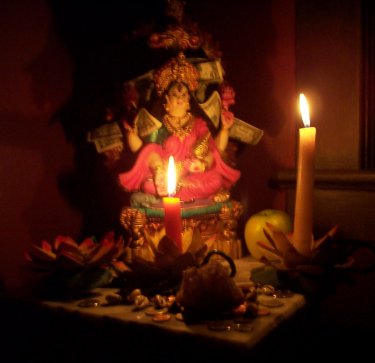
Candles upon an altar to Lakshmi, the Hindu goddess of fortune
Over many years I have often heard the Native American chant "The Earth is our Mother; we must take care of her...", but never sung with the passion of young Clay, who has risked her life to defend a stand of old growth forest east of Portland. Clay and Leaf live days and sleep nights on platforms fifteen stories above the ground in ancient redwoods, where they are brought supplies by the environmental action networks, hunted by police with dogs, harassed with helicopters, threatened, arrested, and put on probation, which turns out to be an endless series of intimidations and life restrictions. Clay told me that the day before her arrest in a dawn raid, she realized she had come to a state of intimate knowledge of the forest by sitting quietly and observing for many weeks. "I knew which birds would come out at different times of day, what happened in the forest as the light changed. I want to go back to the forest. My probation forbids it. I have been working in the office providing support for the others, but it's not the same. I love living outside."
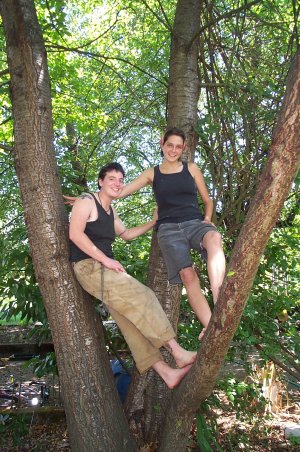
Leaf and Clay visit the Temple during a break from tree-sitting
Marna Hauk chants in a full, strong, melodious voice, and improvises with mastery. She built the cob goddess with the candle-lit chakras on the front porch of the Full Circle Temple, and she worked on the cob kiosk at the Lost Valley Educational Center as an apprentice to Becky Bee.
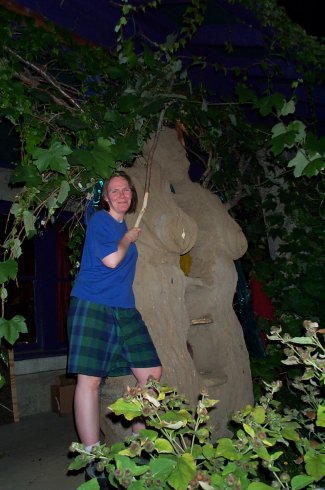
Marna with her cob goddess scultpure
Raven lead the new moon ritual, singing in a tender soprano. She made sure everyone felt honored. Later, she volunteered to let me photograph her wings.

In my travels, I have encountered only two cultures that openly appreciate the beauty of corpulent women--the Polynesians, and lesbians. The rest remain hypnotized by Modernist media's official approved female form. Naomi Wolf, in her book The Beauty Myth, notes that hungry people are compliant, and that historically, the more powerful women become in the world, the more that media slings back an impossibly slim role model. Examples: The flat-chested, leggy flapper came into fashion directly following Women Suffrage in 1920. Twiggy appeared about the same time as Ms.

"True wealth is green plant energy"
(Gary Snyder)
Calligraphy by Flora Rose
I met Flora Rose in the kitchen the following morning, gathering and sorting the Temple's recyclables for collection. "I do this service as a donation to the community," she told me. She lives in the country, outside of Portland, where she designed and built her own cabin, grows her food, launches campaigns to protect the environment, makes art and music, and practices and teaches calligraphy, which she studied and taught at Reed College in Portland some years ago. When I asked to photograph her, she offered to sit before the Virgin of Guadalupe altar she created in the healing room. She believes all women are priestesses.
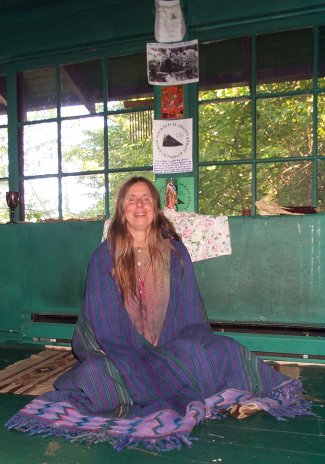
Flora Rose in the healing room
Jasmine left Buffalo, New York, for Portland, at seventeen, in 1997, when she heard about the Full Circle Temple. Here, she immediately became ordained as a minister, she told me, and founded the Temple of Sound in an old building where 200 to 500 young men and women come to dance to a combination of recorded and live electronic music. A rave scene? I asked. "It has its roots in rave, but is taking it to a higher, more transformative level," she told me, "we believe in ecstatic experience as a cultural unifier." On her card: "Tribal house vibration tranceforming the nation".
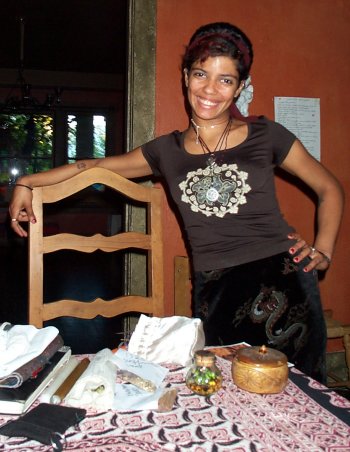
Jasmine unpacks magical books and objects from her bag
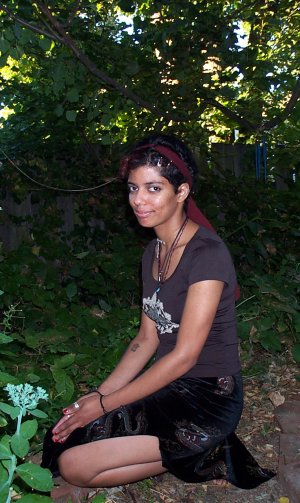
Priestess, dancer and sound healer
Jasmine
communes with the spirits of the Temple garden.